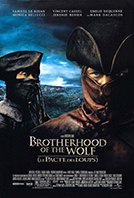Brotherhood of the Wolf

| Original title: | Le pacte des loups |
| Director: | Christophe Gans |
| Release: | Cinema |
| Running time: | 142 minutes |
| Release date: | 31 january 2001 |
| Rating: |
Mulder's Review
First discovered in theaters when it was released in January 2001, we were able to revisit this timeless masterpiece of French cinema in its reworked 4K version and in its extended version. With only four films in over 29 years of career, Christophe Gans is certainly one of those directors who have left their indelible mark on world cinema, whether it is a memorable sketch from the film H.P. Lovecraft's: Necronomicon (1993) or his other films Crying Freeman (1995), Silent Hill (2006) and Beauty and the Beast (2014) and of course Brotherhood of the Wolf. Far from being confined to the American adventure film with a pharaonic cast and outrageous special effects, this film is a true tribute to cinema by approaching other genres such as the action film (with Asian inspiration), the horror film (with its ferocious monster) but also the costume film that made the reputation of French cinema.
Director and screenwriter Christophe Gans has always conceived his approach to cinema as a way to break out of a preformatted framework and give life to works that have nothing to envy to American cinema. A true cinema enthusiast since childhood, his films bear witness to his Asian and American influence with a very personal way of making a film, constantly seeking to find the best possible approach to each scene. For his second feature film, Christophe Gans does not take the easy way out and is given a considerable budget to give him the means to complete what he will later call his Apocalypse Now, a superhuman challenge shot in natural landscapes and benefiting from an excellent cast with, among others, Samuel Le Bihan, Vincent Cassel, Émilie Dequenne, Monica Bellucci, Jérémie Renier, Mark Dacascos and Jacques Perrin in important roles.
It is no coincidence that Brotherhood of the Wolf begins with an overflight of a rural French province and the appearance of a young woman who seems to be fleeing a dangerous and ferocious enemy that we only later see is an animal imported from Africa and trained to kill and bring out a boundless rage against humans. As this mysterious creature ravages the countryside, savagely killing dozens of women and children, the inhabitants are truly afraid of ending up under its claws and bite. Invisible, endowed with enormous strength and human intelligence, the beast has eluded capture for years and King Louis is forced to send a knight Gregory de Fronsac and his Iroquois blood brother Mani (Mark Dacascos) to help the inhabitants track down the so-called Beast of Gévaudan (which became after the French Revolution, Lozere). These two lonely heroes will not only find themselves confronting a cult but also uncovering a real plot against the King of France.
To better appreciate the real strength of the film Brotherhood of the Wolf it is necessary to put it in its historical context, that is to say in 2001. At that time, French cinema was more famous for its auteur films and some films by Luc Besson, also a virtuoso director whose American influence can be felt in each of his films. The very structure of the film suggests a succession of several parts and a desire to offer a film almost perfect and in which nothing is left to chance. While it could have been a simple monster hunt, the script takes a malicious pleasure to propose several narrative arcs in order to develop the psychology of the characters and to propose fight scenes rarely seen in a French film. The presence of actor Mark Dacascos (Only the Strong (1993), John Wick Parabellum (2019) among others) gives the film some of its best action scenes before actor Samuel Le Bihan takes over for the last part of the film and proves to be equally at ease in action scenes as in more intimate moments. We can also appreciate the presence of a striking female cast with notably the too rare Émilie Dequenne and Monica Bellucci.
The cutting of the film allows us to discover it with the same pleasure we take in turning the pages of a book. Despite the many years that have passed this film has kept all its strength and continues to amaze us. We only regret that the director Christophe Gans was not able to make films that were close to his heart such as Nemo, Corto Maltese and we hope that the re-release of this film will allow him to show to a whole new generation of spectators how he remains a director of the French cinematographic landscape.
Brotherhood of the Wolf
Directed by Christophe Gans
Written by Christophe Gans, Stéphane Cabel
Produced by Richard Grandpierre, Samuel Hadida
Starring Samuel Le Bihan, Vincent Cassel, Émilie Dequenne, Monica Bellucci, Jérémie Renier, Mark Dacascos
Narrated by Jacques Perrin
Cinematography : Dan Laustsen
Edited by David Wu, Sébastien Prangère, Xavier Loutreuil
Music by Joseph LoDuca
Production companies : StudioCanal, Davis Films, Eskwad
Distributed by Metropolitan Filmexport
Release date : 31 January 2001
Running time : 142 minutes
Seen on June 10, 2022 at Gaumont Disney Village, Room 8 seat A19
Mulder's Mark:

